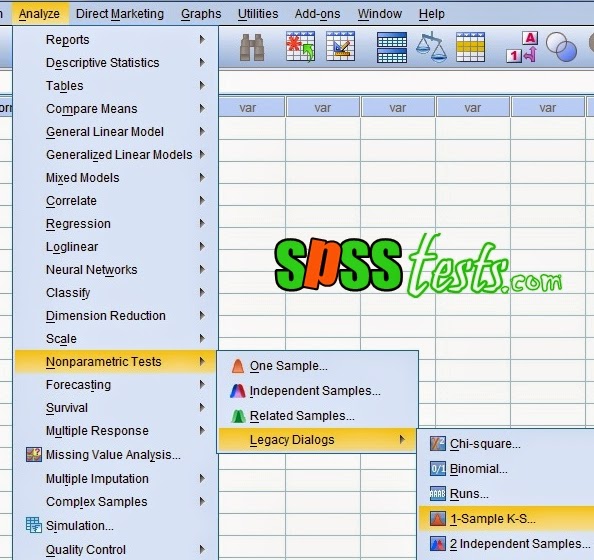
Distribución normal y Prueba de normalidad KolmogorovSmirnov y Shapiro
The Shapiro-Wilk test examines if a variable is normally distributed in some population. Like so, the Shapiro-Wilk serves the exact same purpose as the Kolmogorov-Smirnov test. Some statisticians claim the latter is worse due to its lower statistical power. Others disagree.

How to test normality with the KolmogorovSmirnov Using SPSS SPSS Tests
This video demonstrates conducting the Kolmogorov-Smirnov normality test (K-S Test) in SPSS and interpreting the results.

Cara Melakukan Uji Normalitas Kolmogorov Smirnov Dengan Spss Spss
The Kolmogorov-Smirnov test uses the maximal absolute difference between these curves as its test statistic denoted by D. In this chart, the maximal absolute difference D is (0.48 - 0.41 =) 0.07 and it occurs at a reaction time of 960 milliseconds. Keep in mind that D = 0.07 as we'll encounter it in our SPSS output in a minute.

Conducting a KolmogorovSmirnov Normality Test (KS Test) in SPSS YouTube
How to Report P-Value of Kolmogorov-Smirnov and Shapiro-Wilk tests of normality Table in SPSS Output? The third table shows the results of Kolmogorov-Smirnov and Shapiro-Wilk tests of normality (tests statistic, degrees of freedom, p-value). Since we have less than 50 observations (N = 32 < 50), we will interpret the Shapiro-Wilk test results.

Kolmogorov Smirnov Test mit SPSS YouTube
The bottom line is that the Kolmogorov-Smirnov statistic makes sense, because as the sample size n approaches infinity, the empirical distribution function \(F_n (x)\) converges, with probability 1 and uniformly in x, to the theoretical distribution function \(F (x)\).Therefore, if there is, at any point x, a large difference between the empirical distribution \(F_n (x)\) and the hypothesized.

Sage Research Methods Datasets Part 2 Learn to Use the Kolmogorov
SPSS runs two statistical tests of normality - Kolmogorov-Smirnov and Shapiro-Wilk. If the significance value is greater than the alpha value (we'll use .05 as our alpha value), then there is no reason to think that our data differs significantly from a normal distribution - i.e., we can reject the null hypothesis that it is non-normal.

Testing for Normality of Distribution (the KolmogorovSmirnov test
Illustration of the Kolmogorov-Smirnov statistic. The red line is a model CDF, the blue line is an empirical CDF, and the black arrow is the KS statistic.. In statistics, the Kolmogorov-Smirnov test (K-S test or KS test) is a nonparametric test of the equality of continuous (or discontinuous, see Section 2.2), one-dimensional probability distributions that can be used to test whether a.

Kolmogorov Smirnov Test of Normality Non Parametric Tests Using SPSS
Kolmogorov Smirnov Test (KS Test) in SPSS. Step 1: Analyze → descriptive statistics → explore. Step 2: Move the variables you want to test for normality over to the Dependent List box. Step 3: (Optional if you want to check for outliers) Click Statistics, then place a check mark in the Outliers box.

How to do Normal distribution tests in SPSS Kolmogorov Smirnov
Elevate your SPSS skills with our in-depth tutorial on the Kolmogorov-Smirnov One-Sample Test. Learn how to assess data normality and interpret the results e.

Kolmogorov Smirnov Two Samples Test using SPSS YouTube
The Kolmogorov-Smirnov test is a nonparametric goodness-of-fit test and is used to determine wether two distributions differ, or whether an underlying probability distribution differes from a hypothesized distribution. It is used when we have two samples coming from two populations that can be different. Unlike the Mann-Whitney test and the Wilcoxon test where the goal is to detect the.

KolmogorovSmirnov Test (KS Test) of Normality for Each Level of
The two well-known tests of normality, namely, the Kolmogorov-Smirnov test and the Shapiro-Wilk test are most widely used methods to test the normality of the data. Normality tests can be conducted in the statistical software "SPSS" (analyze → descriptive statistics → explore → plots → normality plots with tests).

Normality test in SPSS KolmogorovSmirnov ShapiroWilk Normality
Step by Step Test of normality with the Kolmogorov-Smirnov Using SPSS. 1. Turn on the SPSS program and select the Variable View, next, in the Name write Competency and Performance. Ignore the other options. 2. The next step, click the Data View and enter research data in accordance with the competence and performance variables. 3.

kolmogorov smirnov test using SPSS YouTube
The One-Sample Kolmogorov-Smirnov Test procedure compares the observed cumulative distribution function for a variable with a specified theoretical distribution, which may be normal, uniform, Poisson, or exponential. The Kolmogorov-Smirnov Z is computed from the largest difference (in absolute value) between the observed and theoretical.

One Sample KolmogorovSmirnov Test in SPSS YouTube
We will next look at a statistical test to see if this backs up our visual impressions from the histogram. The Kolmogorov-Smirnov test is used to test the null hypothesis that a set of data comes from a Normal distribution. Te s t s o f N o r m a l i t y Kolmogorov-Smirnov Statistic df Sig. Science test score .025 5194 .000 a.

SPSS Kolmogorovsmirnov Analysis
SPSS Statistics allows you to test all of these procedures within Explore. The above table presents the results from two well-known tests of normality, namely the Kolmogorov-Smirnov Test and the Shapiro-Wilk Test. The Shapiro-Wilk Test is more appropriate for small sample sizes (< 50 samples), but can also handle sample sizes as large as.

SPSS Tutorial 17 KolmogorovSmirnov (KS Test) YouTube
This video will guide you on how to solve test of normality (Kolmogorov-Smirnov) by using SPSS.for more information.click here : http://statisticisfun.blo.